#Gothic Lineage
Text

11 notes
·
View notes
Text
Making breakfast only to freeze up like a deer when the most wretched idea popped into my head and am now strapping myself to the couch because if I even glance at my laptop it is over for me.
#Telling myself that if I succumb to this madness there is no coming back from it.#I even scoured youtube and I'm shocked that no one's made this connection when there's entire YT personalities#that have made this their entire careers.#YOU GUYS IT'S RIGHT THERE. HOW HAVE YOU NOT PUT TWO AND TWO TOGETHER???#but I guess applying literary analysis to a video game franchise isn't exactly common given how much research it'll require#especially if you're not already lost in the literary sauce I guess.#Good god the temptation is so STRONG......#I'm either a genius or just insane tho I'm leaning towards the latter.#..... i feel like this would make a certain someone cry.#'You're reaching' you say. 'Yes' I retort#'But I can trace the lineage of genre evolution all the way back to the great 18th century Gothics#and by looking at the trope conventions--'#*distant sound of a piano crashing*#..... i may be slightly manic today
4 notes
·
View notes
Text
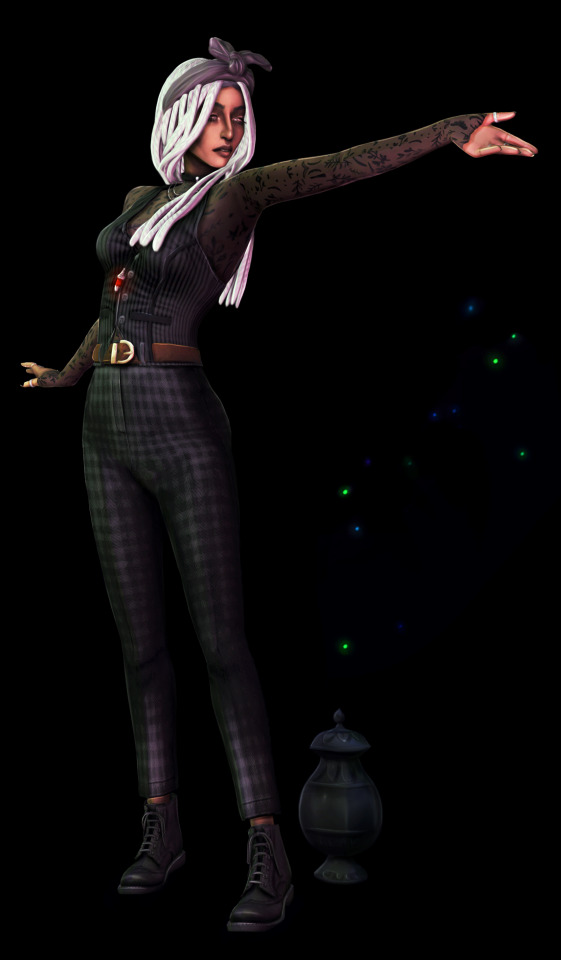
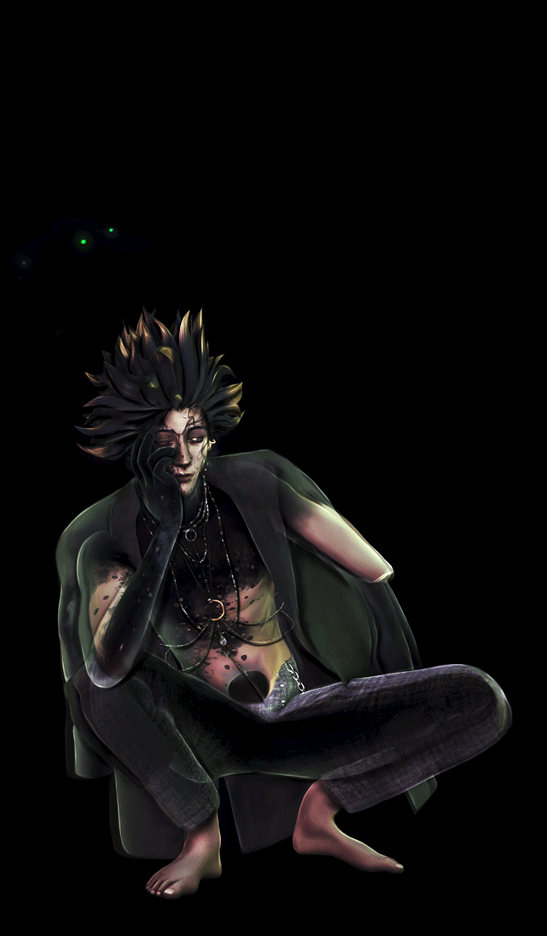
Dynamic: Mentor / Mentee
Genre: Southern Gothic
@tricoufamily's duo challenge!
-ˋˏ✄ ━━━━━━━━━━━ ⊱⚱️⊰ ━━━━━━━━━━━━━ ⋆˚ ‧
⌞ When Heather Charm, the sole non-magical member of her sorcerous family, seeks acceptance from her mother, she forms a pact with a mysterious spirit, who promises to teach her the secrets of magic. ⌝

Amidst the vast halls of the Charm family, where magic infused every corner with its presence, Heather Charm stood as the peculiar exception. Niece to the esteemed Minerva Charm and cousin to the gifted Darrel and Gemma Charm, Heather bore the weight of her lineage with a heavy heart. Branded as the family's black sheep for her lack of magical prowess, she harbored a fervent desire to redeem her honor.
With determination ablaze within her, Heather delved into realms beyond conventional magic. Venturing into the enigmatic world of psychic phenomena, she sought solace and strength amidst the whispers of her family's disappointment.

In a moment of audacious resolve, Heather forged an alliance with a potent spirit, binding it to her very essence. In this pact, woven from threads of desperation and ambition, the spirit pledged to guide her along the path less trodden, promising to unearth the latent power that lay dormant within her ancient bloodline.
— But in the shadows of uncertainty, whispers lingered.
····································
➺ using the psychic mod !
(@itsmariejanel I always imagined Heather as also being Jace's cousin as I played her a while back 🤭 However, it's time for her to inhabit her own universe 👋🤧)
#tricoufamily duo challenge#the sims 4#sims 4#ts4#sims 4 mod#sims 4 spellcaster#Heather Charm#sims 4 cas challenge#gif
197 notes
·
View notes
Text

As per usual, info under the cut <3
IM BACK BITCHES!!!
Alright, here's the design stuff:
I wanted to go for kind of a Lois Lane vibe, including the way she gets all the way up in business she should not be up in. At the same time I wanted to bring the super cutesy gothic lolita style in at least a little. So I ended up going with a poofy short jumpsuit with bows and teddy bears. I would love to make a specific thank you to @themooncallsyou for suggesting I look at the Moschino 2022 spring line for inspiration, it ended up having a very heavy impact on the final design.
I tried to lean into the investigative part of investigative reporter, so that's what the heavy coat is about. I thought adding that classic detective silhouette would be a nice final touch. Plus, I think Blondie likes the drama of the coat flying behind her as she's chasing down a lead. It makes her feel very cool.
Alright, so her original pet is a bear cub named Grizz but I have. Several problems with that. The main one is that it's not clear what the difference between Grizz and the actual sentient bears and her story is. There is never any differentiation between them. It's a Goofy-Pluto situation. Like it doesn't need to be explained, but the minute you start thinking about it too hard it gets weird real fast.
Anyways say hello to Honey the magpie!! Magpies are great mimics and lovers of shiny things, so I thought one would be a perfect fit for Blondie. She repeats bits of gossip and steals little trinkets and clues to help Blondie with whatever case she's on. Honey is where Blondie gets her infinite supply of bobby pins. Her scale is a little off, I don't think magpies are actually that big, but I still think she's cute so I'm not changing it now lol.
Now for character stuff:
Honestly I'm not really changing anything as much as I am exploring what's already there. I think Blondie has the potential to be really interesting, because she's unique within the class system of the school. She's kind of the inverse of Raven status-wise. Raven was born to royalty, but because her mom is the Evil Queen she's actually considered a commoner by society. Blondie was born to a wealthy commoner family, but her fear of rejection leads her to exaggerate the prestige of her lineage. Everyone sort of knows that she's not a Princess but she's so desperate to keep up the image of royalty that no one knows where she actually lands. Most of the royals assume her parents are Lord and Lady or Duke and Duchess or something. In reality they don't have any noble title, and Blondie is very insecure about that.
Blondie isn't so much ashamed of her family as she is terrified of exclusion and rejection. Her standing in society is the one major thing that makes her different from all the other royals, but she has major anxieties that she's always on thin ice. In her mind she's permanently one wrong step from total ostracization.
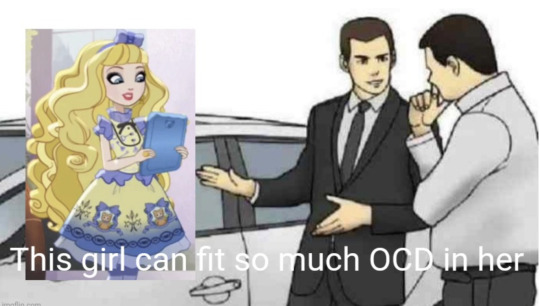
On a happier note, she does have a genuine passion for journalism! She considers her news blog/podcast practice for her future career. She starts out discussing school drama and gossip, but tries to stay a neutral third party. That's why her hair is so big. It's full of secrets. As the story goes on she starts reporting on more political and social topics beyond the boundaries of the school (and therefore becomes one of Milton Grimms worst nightmares). She is really, really, really good at getting into shit people do not want her to get into. She's got her eyes on prize and good luck stopping her
#eah#ever after high#coffeepaintart#eah fanart#blondie lockes#eah art#yes i have thought about this cartoon for children designed to sell dolls from almost a decade ago for far too long why do you ask#eah redesign
263 notes
·
View notes
Text
Jack Seward: Vampire Coded
I really like the theory of Jack being vampire-coded, not only because he is a foil of Dracula but because it shows how the abuse of power can come from within the house (or rather within the asylum). So here is a list of vampire-like traits he's exhibited so far:
-Has a good forehead and strong jaw, just like Dracula is described as having a prominent forehead and "strong chin"
-Doesn't sleep at night except for the help of chlloral
-Monologues about the "natural order of things". Dracula with his lineage and warrior blood and Jack with his superior rationality over Renfield.
-Jack is described by Lucy as having an intense stare and wanting to psychoanalyze her (later Renfield), which implicitly recalls how Dracula has power over Lucy through his hypnotizing red eyes.
-Uses a lancet, which is a small instrument for blood letting. Speaking of blood, he describes Renfield as having a "sanguine" temperament twice. What's next, drinking blood?
-Feels lonely and compelled to love someone, just like Dracula wants to "love" Jonathan. Now this is pretty interesting -- Jack is more like a gothic brooding hero that Dracula tries to be in a lot of media adaptations. He's in love with Lucy and yet he uses Renfield as a replacement.
-Being alone vs being lonely. Dracula is lonely, even though he lives with three vampire women who are familiar with him. Jack has friends who he keeps at a distance because of unrequited love. Of course this is a bit of a stretch as we tend to think of all three suitors as a parallel to the vampire women, but I'm throwing this in anway.
Again, this isn't like definitive, but I thought it was interesting!
#dracula daily#john seward#jack seward#dracula (novel)#thebibi on vampirez#yes im implying jack could have a harem of men if he wasn't a coward
335 notes
·
View notes
Text
"You and I Have Begun to Blur"
This is eating my brain from inside, so here's the thing: one of my favourite aspects of Hannigram as a ship is their balance - the way they mirror and complete each other, functionally two halves of the same whole; but what is even more fascinating is that, in a literary sense, Hannibal and Will are, in fact, inspired by two opposing aspects of the same man.
It all begins (like many other things) with Lord Byron; specifically, the summer he spent with a group of friends at Villa Diodati in Geneva, and the dare, that each member of the group would write a ghost story - one of which was Dr. Polidori's The Vampyre. This novella, which introduced the vampire legend to Western popular culture, defined its archetypes for centuries to come; and as such, Polidori's Lord Ruthven, who was based on Lord Byron, became a blueprint.
He is dark, foreign, seductive, dangerous, hypnotizing, hedonistic, possessive; his relationship with the main character, Aubrey, is markedly homoerotic - and these qualities endure as the archetype is passed down the generations. From Ruthven, we get Carmilla, Dracula, Lestat - and, indeed, Hannibal Lecter.
From this:

To this:

he is still, recognizably, a Byronic villain. Whether he operates within an overtly supernatural genre, or a psychological thriller, he is still confident, dominant, manipulative, and always representative of forbidden (queer, interracial, extramarital, etc) desire and temptation.
However, The Vampyre was not the only piece written for the same dare, not the only piece that left a legacy within popular horror, and, most importantly for this context, not the only piece that featured a Byronic character. Mary Shelley's Frankenstein introduced a second such archetype into the gothic genre - inspired by her own understanding of Lord Byron; so, while her Victor Frankenstein shares the same dark hair and pallor as Polidori's Ruthven, there is an ocean of differences between the two.
Victor Frankenstein is a Tortured Genius. He is odd and wild, passionate, prone to isolation; a misfit from the start, always lonely despite the few connections he has, and never truly understood. His intellect is both a gift and the source of his ruin, and he is plagued, in equal measure, by both pride and guilt.
In both looks and character, he passes almost unchanged - from this:
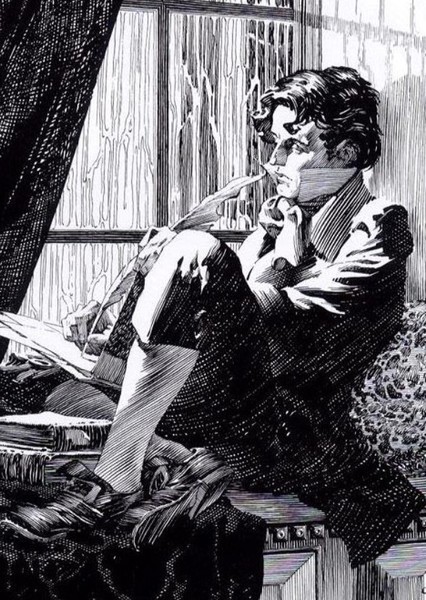
To this:
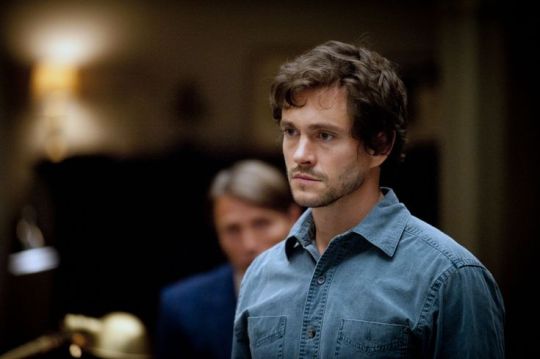
Even centuries later, he is still the smartest man in the room, he is always tormented, and his counterpart is always a Monster. We see him pop up throughout horror media - as poets, composers, detectives - reflected in Edgar Allan Poe's Roderick Usher, Lovecraft's Henry Wilcox, or Spencer Reid of Criminal Minds. Unlike those of Ruthven's lineage, these people are usually either frail or sickly, socially awkward, uncertain of themselves except for a specific area of expertise, and their sanity commonly tends to be in question.
Despite such differences, though, all these characters are Lord Byron's legacy, weaving their way through history - on the page, on the stage, on the screen, it matters not. By the time they meet again in NBC's Hannibal, they are as separate as two entities can be - yet entwined more closely than any other genre would allow.
Frankly, it drives me feral.
There is so much here to unpack - they are a whole, and yet separate, each with his own archetypal history. Does something within Will Graham's bones remember Frankenstein when he stands in the forensic lab, surrounded by corpses?.. On the Doylist level, does that inform the acting - however subconsciously - in any way?.. Does Count Hannibal Lecter have Lord Ruthven's smile - or Lord Byron's?.. Does he know?
How much is reality?
How much is fiction?
How much is lost through interpretation? How much is remembered? How much does anyone ever really Know us, truly, when two of Byron's closest friends saw entirely different people in him?
I don't know. We can never know. What is evident, though, is that Hannibal Lecter and Will Graham are two halves of the same soul - and that this soul aches to be complete.
#hannibal#hannigram#hannibal lecter#will graham#dracula#victor frankenstein#gothic fiction#gothic#gothic literature#literature#history#nbc hannibal#hannibal nbc#hannibal meta#hannibal analysis
99 notes
·
View notes
Text
Thanks to my post about the 28th, it’s come to my attention that a significant portion of humanity don’t read history books for fun, so here’s a few broad strokes of what, exactly, is going on with the cultural connotations of race within Dracula, as understood by an American:
European racism of the day was predominantly based on cultural ethnicity rather than skin color, and one of the main sliding scales (other than how old and prestigious the ancestry was) was how far west you were on the Eurasian continent. The further east you went, the less “civilized” things became, until you hit Asia and Oceania and just became inundated with absolutely rancid racist caricatures. Stuff from the “Orient” was there for exotic/shiny toys and moral lessons about how much better the West was, and not much else, so you can imagine what depictions of actual Asian people thus became.
(We’re faced with this east vs. west scale in Jonathan’s very first entry: Budapest straddles the line between the “civilized” western part of Europe and the “uncivilized,” opulent, and exotic world of eastern Europe. Jon is going from the known and familiar city into the mysterious, unfamiliar wilderness, an extremely common Gothic horror archetype.)
Both the fear of the unknown and the exoticizing/othering of Eastern Europe play heavily into Dracula’s themes, with the sexually predatory Count Dracula coming to England to do all sorts of unspeakable sordid things to innocent English women. (Not exactly Stoker’s finest hour, but this was a typical attitude of the day.)
Following that, it was also thought at the time that one’s moral character was essentially genetic. Certain people of certain races were predisposed to be “better” or “worse,” and your own moral character was also influenced by your parents’ status in society and behavior. A prostitute mother or a criminal father meant you would inherit their dubious moral quality, which is partially where “this person has bad blood” comes from. Bad blood is literally the negative morality passed onto you from your parents: you’ve inherited the bad qualities carried in their blood.
Linking back to the east-west thing, the further east you go -you’ve guessed it- the worse this supposed ancestral bad blood gets. People of “lesser” races included the Romani, Jews, Slovaks (and sometimes the Russians), and they were just supposed to be, like, naturally inclined to be bad. They were Programmed For Crime from the moment they were born, so you didn’t need to explain why such a character was evil when they showed up in your novel: I mean, they’re [INSERT RACE], aren’t they? It’s in the blood. No explanation needed. Everybody knows that.
The assumption of the time was that such people were literally born bad, which of course naturally justified how they were treated. When they showed up on a page, you were supposed to distrust them on sight.
Occasionally, low-class people were also treated as a race all their own, like poverty was some kind of moral failing. After all, the older, more prestigious, and wealthier your family was, the better their inherent moral quality, so poor people are obviously uncouth and have bad blood, right?
(It’s an extremely stupid circular way of thinking, but that’s bigotry for ya.)
Dracula is a nobleman with old lineage, but he’s also steeped in the flavor of Eastern Europe: “barbaric” and proud, yet initially treating Jonathan with extreme courtesy; threateningly exotic and yet also familiar with English customs. As we go through the book, you’ll see that he almost exclusively hires Romani, Jewish, or extremely poor for his henchmen: he’s a force of evil that uses other “evil” tools, who bend easier to his will than “normal” people of “proper” races.
(By all means, please pause here a moment to scrub yourself of the nauseating feeling that such a bullshit attitude evokes.)
In any case, Dracula himself is a pretty good example of all these racial ideas converging, which was also why he made such an effective monster to the Victorians: there’s just enough that’s familiar and proper in him that they couldn’t quite properly Other him, which links back to the transformative horror of vampirism turning something formerly good into something very very bad, which with their worldview of “you are born with this moral code because of racial predisposition and lineage” is just shocking. You mean this Eastern European man can infect our formerly good and pure citizens and make them act his way, just by an act of force? Uh-oh.
Anyways TLDR Dracula is a book steeped in the cultural traditions and expectations of the day which means that it’s lovely horror but also an absolute crock of shit at times due to racism (and several other -isms, which I will not cover here because I am trying not to make this an essay).
276 notes
·
View notes
Text
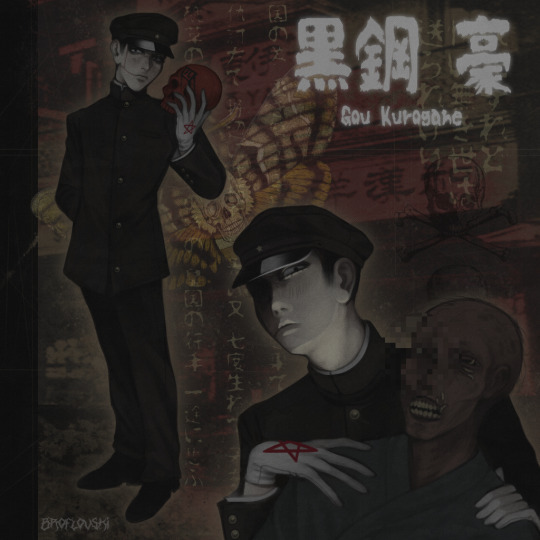
Ok I'm so obsessed with "Dai Nippon Gothic" and Suehiro Maruo's artwork and manga, I ended up getting a lot of inspiration from that to continue Akumu's mistery lore. I'm doing characters for the secret occult club investigating her death. They're called "Mugen no Kagi" (夢幻の鍵) or just "Fantastic Dream Key". I'll post the other members during the week bc I think each one deserves a post only about them, so here's the first one: Gou Kurogane
His backstory may contain some extreme/disturbing topics, be warned:
Gou is a 17 y.o teenager who is part of the secret occult club that investigates the entity Akumu. He is fascinated by death in every way. Coming from a traditional family and a lineage of samurais who served the Shogun, he follows a strict code of honor since he was a child. His family has a strange tradition of preserving the corpses of men who brought honor to the family in a sacred room in the house. His dream is to bring honor and die heroically in the war to have his body mummified alongside his ancestors, keeping the illusion that "war is honorable" due to his family tradition and the nationalist education given by the schools during the Showa period. He constantly has the job of serving food to the corpses and taking care of them as if they were alive.
Gou's father divorced his mother when Gou was very young and lost himself in alcoholism and prostitutes. Because of that he rarely sees his father and was raised most of the time by his older brother, who has a toxic and abusive relationship with him. Gou's brother is an imperial soldier, and constantly puts pressure on him, saying that "he will never bring honor to the family". Even though he gets excellent grades and being very good at swordsmanship, his brother invalidates his success, and nothing ever seems to be enough to please him. Although, Gou greatly admires his brother's position in the army, and dreams of becoming a soldier just like him and is deeply ashamed of his father and has vowed not to end up like him.
Despite all the problems and oddities, he is a very respectful and modest person in public, which makes people see him as someone exemplary in society and they don't even imagine his creepy side.
All this fascination with death made him start looking for more answers in black magic, and so he joined the secret occult club. Out of all entities and Yokai, he has the most interest in vengeful ghosts (like the Yurei type of ghost) and the Gashadokuro (giant skeletons made of the skulls of people who died in the battlefield). He is constantly desecrating warriors' graves and taking their skulls in the hopes of one day summoning a Gashadokuro. He doesn't usually work with curses and tends to focus more on summoning disturbed spirits and finding definitive ways to invoke each one of them, recording everything in his summoning notebook. He believes he can free Akumu's spirit and find out what happened to her.
*I don't condone the japanese imperial army and their actions nor the act of desecrating graves/disturbing the dead. The character is just inserted in this specific moment in history. Take his attitudes and traumas as a critique of how nationalism and extreme traditions affect people's minds in the worst way and how war is romanticized by some people.
#art#digital art#my art#digital drawing#drawing#oc#dark#aesthetic#wwii#historical#historical oc#dainippongothic#horror#japanese horror#corpse#Oc:Gou#also the asks are open again!#original character
151 notes
·
View notes
Text
It's always really difficult to choose between An Opera of Fear and A Cold Alliance for my favourite Sly 3 episode, but it's safe to say that Flight of Fancy is easily the most nostalgic. Not because it's rooted in my childhood memories (it is) but in the sense that it shares elements with episodes from Sly 2 during a game which presents the gang at the peak of their career. Let's discuss
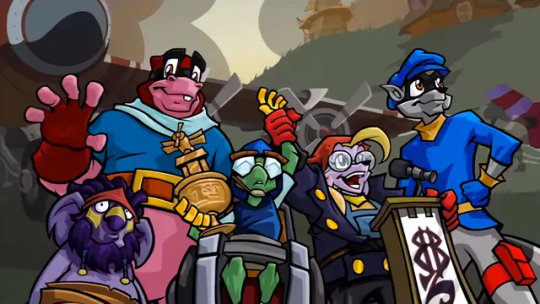
I think we can all agree that the series very effectively presents the gang's development, not only as individual characters, but also as a team of thieves. Sly 1 shows the gang as teens during their first set of adventures which sprout from Sly's desire for vengeance. They make many mistakes, they don't really have planned heists or jobs - Sly just casually goes into every level breaking shit and then faces off the big baddie - and they surpass their own expectations of themselves to defeat Clockwerk in the end. Then, Sly 2 covers a crucial point in the gang's career. It felt as if up until this point they hadn't truly fucked up so they went into it being very cocky, especially Sly. And when they got their asses handed to them by Neyla, getting separated tested their individual and collective limits.
In Sly 3, the gang has evolved to master thieves, capable enough to feel comfortable recruiting and as such mentoring strangers and also worthy enough to inherit an entire lineage's stolen loot. This is also shown in the missions, which up in scale and spectacle. It's no longer just "follow this villain" or "pickpocket this person". It's a combination of missions we grew accustomed to during Sly 2 like "follow Octavio and do recon under time pressure", or something completely new. Right off the bat, for example, we send a ferris wheel rolling across Venice squashing guards in its way, like this is just a mission not Thunderbeak or something. Every Sly 3 mission evolves explosions, high-tech and the eventual mini boss-fight.
So it's then a bit surprising to see the gang reverting to their sneakier, more subtle ways during Flight of Fancy. That's not to say we don't have explosions and thrill in the episode (the dogfights, Muggshot vs Carmelita, wolf-riding, shooting literal fucking windmills into blimps), but the way they choose to sabotage the competition due to how delicate its internal politics are creates some nostalgia. Paddling around the sewers in a blow-up rowboat and breaking into the pilots' rooms is very Sly 2. It felt like something 18 year old Sly would do. Also, scaling the Baron's castle harks back to Sly 1's platforming and is reminiscent of how small Sly would seem when approaching a villain's daunting lair.
The design choices for the Netherlands seem primitive too, enhanced by the fact that we're in the countryside. I feel like there's that Sly 1 and 2 rule of thumb at play here, where Sucker Punch chose the aesthetic or genre first and then chose the location. For example, they wanted a spooky level in Sly 2 so they chose Prague which would accommodate the genre through its architecture and gothic character. That allowed them to exaggerate a lot in terms of level design. And it's the same for Flight of Fancy, where we have a spooky castle on top of a very cartoony hill and you can hide under haystacks. Oppositely, the rest of the game's levels seem to have departed from the previous entries' design principle (except Kaine Island, which is fully fictional). It feels as if SP chose Venice and wanted to play up how European it is, or the wilderness of the Australian outback but without any radical stylistic choices. The genres are explored through the narrative, not through design.
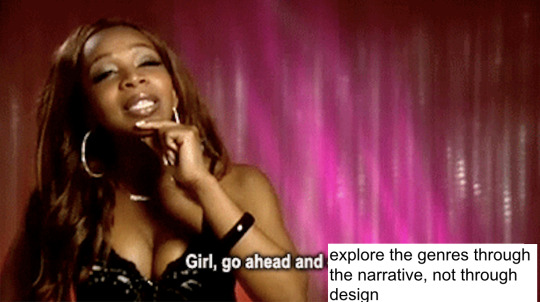
Lastly, let's close off with some Thieves in Time slander because it wouldn't be a signature me tumblr essay without it. If we really use the entirety of our brain power and manage to look past all of the game's bullshit, one additional flaw would be how it doesn't consider the gang's development when telling its story. I'm not saying that in the series' fourth game the gang should have been infallible or indestructible due to achieving master thief status in Sly 3, but here the mistakes they make feel so unnecessarily stupid and like shit they wouldn't have done even in Sly 1. Falling for Penelope's schtick twice; Sly letting his guard down during the Le Paradox boss fight after the Contessa; whatever the fuck went down in Arabia... yea.
#sly cooper#self-restraint means writing a tumblr essay without using gay vernacular as a replacement for words
36 notes
·
View notes
Text
If you liked any of The Adventure Zone stuff before but fell off you need to check out TAZ VS DRACULA
Have you ever imagined what it would be like to listen in on a home game of a Family who have been playing DND consitently with eachother for almost 6 YEARS? That is what TAZ: Drac is like i will share more specific examples below under a page break to spare your dashes
But for anyone who dropped off at balance because "they can never get better than that"
Each TAZ: Drac episode starts with a monolouge from Dracula and then the intro theme is a gothic metal cover of the balance theme (Deja Vu by Mort Garsen)
As for those examples i mentioned:
Griffin is having fun DMing a campy horror world with such characters as Wolfman, Doctor Frankinstien and Robert Halloween
Justin is having fun getting 200% in character as an old aristocratic women who got frankenstiened on top of a classic DND barbarian
Travis is having fun being the guy thats good at stuff as last of his lineage from generations of monster hunters
And clint is having fun being a unpredictable goofball as a Preist Artificer with a checkered past
And i feel like griffin is really leaning into everyones strengths well
He Gives Justin insane character moments (no spoilers but to quote travis from episode 7 "i have never seen justin so thrilled by a turn of events in DND before"
Beefing Travis up with a bunch of "you have trained your whole life as a monster hunter your so good at this" moments
And not shutting down any of clints galaxy brain moments (there was one that organically turned into the cliff hanger of the episode because it was so wild they needed a break in episodes to talk through it 🤣)
Its quality actual play content
Thank you for coming to my ted talk
#the adventure zone#dentonic©️®️™️#the adventure zone vs dracula#taz dracula#taz drac#the adventure zone balance#taz balance
45 notes
·
View notes
Text
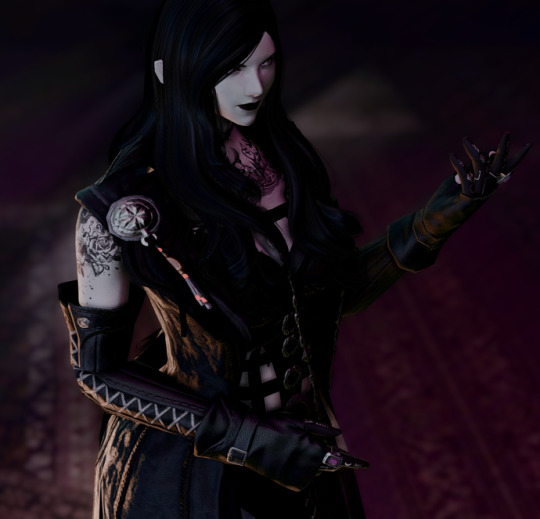

ELANDERVIER AUCLAIR
Nicknames: El.
Age: Mid-to-late forties. I tend to play fast and loose with character ages unless specifics in the story necessitate it.
Nameday: First Sun of the First Astral Moon (once again, you can see I care a lot™ about the birthdays of my characters).
Race: Duskwight Elezen.
Gender: Cis female.
Orientation: You're implying El cares enough to think about it. She's probably somewhere in the sex-positive grey ace/demisexual camp, but let her own lack of consideration speak volumes as to its authenticity.
Profession: Bog-Witch of the Northern Wilds, heretic and retainer to Firelight Trading Company. I imagine there's some kind of mythos around her as being a daemon that eats babies, but I'm hesitant to subscribe any real-world language to it.
PHYSICAL ASPECTS
Hair: Long, wavy and jet black.
Eyes: Amaranthine, though her consort with the void has warped the iris. it is possible to make out some kind of sigil when standing close enough.
Skin: Silvery with pale undertones.
Tattoos/Scars: Ink-dark tattoos permeate every inch of skin aside from her face, though it's hard to know if they were done by a needle or magic. Gothic in nature, their elegance hides a number of symbols that imbue her with power.
FAMILY
Parents: Lord and Lady Auclair were of middling importance and their deaths did not leave an imprint upon Ishgardian society. Elandervier rarely, if ever, speaks of them. She considers her father a spineless coward and her mother a reprobate and a narcissist. Knowing they were left destitute after her actions brought her a macabre sense of glee considering they were willing to forsake her for their own comforts.
Siblings: Her mother claimed she cursed her womb. El replied the insinuation gave her comfort and walked away clawed at the cheek.
Grandparents: Unimportant. The only connection she has to her lineage is down the line to old Gelmorra where she believes her family had prestige.
Others: Elandervier used to be in control of a cabal of voidsent accumulated from her various bargains, deals and trades. One of the few pacts kept after her assimilation to Firelight Trading Company was a voidsent by the name of Gobnip. Gobnip presents himself as an opinionated baby Ahriman who is 'contractually obligated to say all the things Elandervier won't'. Do not be fooled, however. With the right amount of aether, he can reveal his true nature.
While the witch is on retainer to Firelight Trading Company, she holds no allegiance to them proper. The only person she actively obeys is its patriarch, Rexonus; one of the first people she met on her defection from The Holy See, and one of the first people willingly abandoned when her confliction emotions around him and her birth-city came to a head. They kept in touch via occasional letters as she set up shop in the Forelands, and he rushed to her side when the blasphemy's rampage through Etheirys put her life and soul at risk. She made a pact with him, the closest language to love she understands, and uses her pragmatics and knowledge of dark magic whenever it is called upon.
She's not ignorant to the fact he has multiple lovers, she simply does not care. El holds all of them at arms reach, respectable and cooperative when she has to work collaboratively, but otherwise holds no great desire to get to know them. She's friendliest with @riftdancing's Blink due to their similar traits, but even so wouldn't necessarily call her a friend.
The person she has the most complicated feelings towards is Alaice. I won't go too in-depth into why, because it could be a whole post on its own, but it's something about being a mirror and an antithesis for her; of being so similar and diverting so extremely. Alaice is everything El abhorrers and wishes she could be, she hates her and loves her in turn, she finds her futilely weak and unfathomably strong — and she doesn't know where to put those emotions. I always write the two with an undertone of homoeroticism because I can, but also because 'love is consumption' underpins a lot of El's characterisation and it's TASTY to explore. Aka, cannibalism as a metaphor for sapphic love, vampiric 'penetration' being inherently queer, so on and so forth.
SKILLS
Abilities: Mastery over dark magic including thaumaturgy, summoning (voidsent), communion, possession, warding, etc.
Midwifery. El's mother trained her as part of their family traditions and the hope her skills would elevate her as a trusted member of Ishgard high society. Even when defected, desperate women would make the long trek to Anyx Trine for fear of retribution from the Church/High Houses, and she would perform these services despite her hatred of Ishgard/Ishgardians. This is where a lot of the 'baby eater' rumours/myths originate from, as El would also perform abortions where suitable. Mostly this entailed the transference of aether from a non-viable foetus to a viable one — something the men of the gentry did not complain about when it benefited their sons (how odd)! However, El would always defer to what the women wanted over the demands of their husbands, even if this was done in secret.
Hobbies: Studying the history of Gelmorra and it's traditions; foraging for herbs, mushrooms, moss and other things for potions and spells; simmering in pools of water and occasionally turning into slime.
TRAITS
Most positive trait: Elandervier is pragmatic. Above all else, she will contemplate and weigh her choices against any and all outcomes and select the most advantageous result. This may not be the easiest path, either. She is not afraid of tough decisions and hard work.
Worst negative trait: She's spiteful. She's petty. She wants to make people suffer as she has suffered. Her moral compass is misaligned at best, deadly at worst, and she doesn't care for consequence. She's not a good person despite doing a few good things and she doesn't want to be.
LIKES
Colours: Black, green, purple and red.
Smells: Anything earthy. Peat moss, freshy-turned earth and the scent of rain. The rust of blood. That smell you get when you get too close to a fire and you swear it's singeing your nose hairs.
Textures: El is at home with anything that other people find revolting; slimy, spiny, soggy, etc.
Drinks: Though partial to a red, El will drink anything. She can't afford to be picky when out in the middle of nowhere.
OTHER DETAILS
Smokes: When in Firelight Trading Company, yes. Tobacco is hard to come by otherwise, so she ends up quitting by proxy.
Drinks: When she can. Guests often elected to bring her 'offerings' when in need of their services. She wasn't one to complain.
Drugs: This one is tricky. I feel like things like hallucinogenic mushrooms and the like were probably an occasional indulgence, and she's a potions/medicine master of some renown. However, drugs as this sheet implies? No.
Mount Issuance: If Gobnip is big enough she will ride him. :)
Been Arrested: Good luck! Many have tried and failed!
Tagged by: @lilbittymonster — at least for this one! I'm going to try and do one character per tag.
Tagging: @humblemooncat, @chainsofaether, @blackestnight, @mmorpg-escapism, @cadrenebula, @ascendedhypothesis, @ishgard & @allyennah! If you'd like a chance of being tagged, you can like my permanent interaction call here!
#。・゚゚・ — sea speaks#。・゚゚・ — sea answers things#。・゚゚・ — character answers / memes#。・゚゚・ — 𝐜𝐡𝐚𝐫𝐚𝐜𝐭𝐞𝐫 : elandervier#you got one elezen YOU GET THE OTHER
34 notes
·
View notes
Text
I just want to talk about the curious connection between Dabi and Mr. Compress.
When MVA starts, we have 6 members of the LoV, these 6 are the most recognized members. While everyone in the LoV are connected because they share a lot of between themselves, each member have their partner. This duos are thematically connected, their characters share more specific things and usually, their best relationship in the LoV are with this partner. These duos are formed around the main 3 villains: Toga and Jin/Twice (the most notorious duo), Tomura/Tenko and Shuichi/Spinner, and Dabi/Touya and Mr. Compress/Atsuhiro.
A lot was and is talked about the first two duos, so let's focus on the third one.
I think it's not a surprise that despite the fact that Touya didn't want to get along a lot with the LoV, he did. And the one who weirdly had and has a better relationship (the best Touya can do) is Atsuhiro. The two mysterious ones.
What they have in common?
Theater/Dance theme, performance as the core of how they show themselves: While Atsuhiro is more "dramatical" and elegant, we know Touya, when it comes to showing before his family, he does his act, certain poses, phrases, etc, it's more like gothic literature btw (he is like Frankenstein's monster) Both share this theater theme/aesthetic, it's obvious, it's the first trait that its presented about Atsuhiro. While in Touya's case, is something we see later.
The family heritage and believing they are an extension of certain relative, the core of their stories: Core piece of their stories is about the accomplishment of his family heritage, the importance of their family ties.
Touya puts emphasis on being Endeavor's son, explaining that he does what he does because of being his son. He is Endeavor's projection, his continuation, his extension.
Atsuhiro puts emphasis on being Oji Harima's descendant, explaing he does what he does because he has to do what Oji Harima did. He has his blood, he sees himself as his continuation, his extension.
Atsuhiro himself highlights that Touya and him share this thing about being part of certain lineage.
Both let their lifes be about this relative, making it the core of their decisions and actions.
Of course it's extremely different what they lived but the point here is the essential part of the influence of family heritage in their lives.
New identity: Easy, Touya died, Dabi was born.
Atsuhiro before was a magician, an entertainer. But now he is Mr. Compress.
They new identity are their choice, it isn't a reference to someone else, and it's not only a new name and look, it's a whole new life purpose, their new self.
Both hid their true appearances, and revealing themselves is a big show.
Dabi's Dance and Final Performance: Touya's revelation and Atsuhiro's escape "act" are events that happened next to each other. In fact, one is ch. 290 and the other ch. 294. Atsuhiro's revelation follows Touya's. He starts the show with his dance, and Atsuhiro finish it with the League's escape. It all start with Touya first move of presenting himself as Touya Todoroki and ends with Atsuhiro's reverence. And they use the same stage for their show.
Both chapters have this curious theme about staging and their performances. For Touya its the beginning of his show, while for Atushiro, its the final. It's literally in the titles, the show theme is so important.
In these chapters, both reveal their real appearance and present their family ties and how important they are for who they are now.
Another detail is that the last one that Atsuhiro compressed is Touya, giving him something like a high five, looking like some takeover for Touya. Now he is the principal performer, the principal entertainer, it's his show, the beginning of it.
Self destruction as their show: Atsuhiro mutilated himself making the great escape for his friends. He didn't stop until Mirio punched him, but even being hurt, the show didn't stop. Touya is burning himself even more for his show. In Dabi's Dance he burned more parts of his skin, and during this final arc, he looks like a corpse, and it's crucial to his "show", his last show. Also, both do this using their quirks.
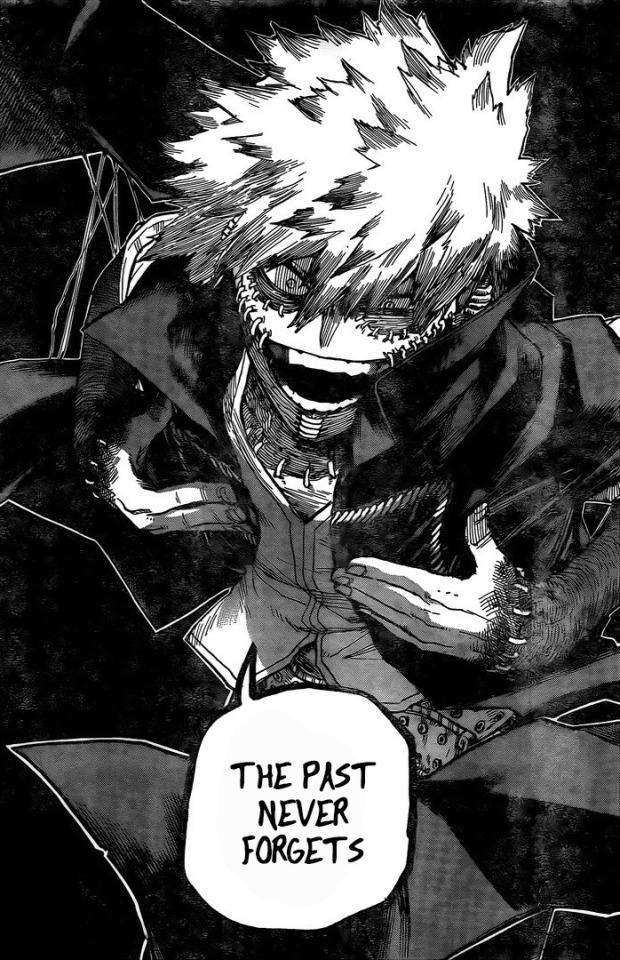
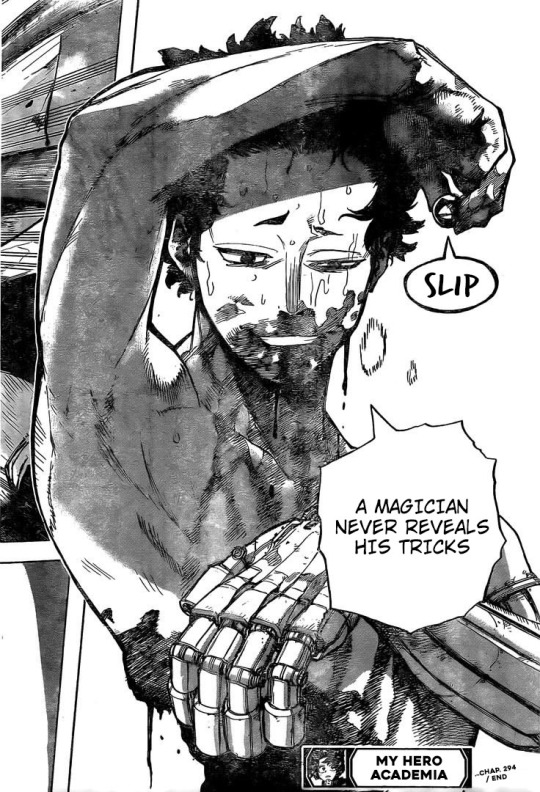
#please I made this meta bc I love their relationship but it has some sense I think#boku no hero academia#bnha#my hero academia#mha#my villain academia#mva#league of villains#lov#dabi#touya todoroki#todoroki touya#mr compress#atsuhiro sako#sako atsuhiro
147 notes
·
View notes
Text
ive been holding off on posting this bc ive been formulating my thoughts (also i never post) but since it seems we're having a racism in the buffyverse/fandom moment (should be every moment!) I figured now would be a good time to vent my feelings on the first slayer.
I do a lot of hobbyist research into the stone age its a long running special interest of mine, and ive just finished writing my dissertation on a number of things including primitivism in contemporary culture. so drawing from that i wanted to expand on the tags I left on the previous post, with the clarification that i am white and european and therefore am speaking from that perspective on this subject.
as far as I can remember, the original Buffy movie had flashbacks to the medieval period, with a white medieval woman in these flashbacks implied to be the first slayer. if that's right and I'm not just misremembering, this would tie in to the pop culture associations of this era with catholicism, witch hunts, gothic castles; all of which further ties into popular vampire lore. however, the tv show leans away from this, with vampires being the only demons vulnerable to christian iconography and most of the worldbuilding drawing from multitheistic (not sure if this is the right word) traditions, preferring pantheons of minor gods, demons as folkloric monsters rather than fallen angels, and the existence of multiple hell dimensions.
the way the show does this is often very primitivist, primitivism here meaning the (often harmful) romanticisation of cultures and eras considered "less advanced", interpreting them as therefore more exotic, interesting, or just plain better than modern western society and in doing so flattening them into solely an appealing primitive fantasy.
examples of this can be seen in the foreign and/or dead languages used in magic and demon research, the appropriated eastern and African imagery used in weapons and costumes, the writing of characters like kendra (who's "people" seem to know a lot about the supernatural but are never actually named), jenny calendar (who carries plot-relevant cultural knowledge from her mysticised "people"), and nikki wood, through whose son buffy learns the ancient - primitive - origins of the first slayer.
the choice to relocate the origins of the slayer from medieval europe to (im assuming, since they never specify) paleolithic africa make a lot of sense in context of the shows de-emphasing of christianity in their vampire lore. this would change the slayer from a warrior chosen by the church to fight unholy creatures, to a defender of humanity at large from folkloric monsters. it also makes the slayer line a lot longer, extending far back into human history.
you'd think.
because the problem is im not honestly convinced anyone writing these episodes knows or cares about the accepted findings that show homo sapiens originated in africa, I can't honestly say it comes across that they were trying to imply that the slayer existed before the first waves of human migration by depicting her as they did. i dont actually know if these characters are intended to come from the stone age or just an ambiguous pre-colonial africa and im being very generous by writing this post the way i have. I think they made the very simple connection of "primitive = cool and mysterious" to "black = primitive". the depictions of the first slayer and first watchers are tangibly racist. their treatment by the narrative is tangibly racist.
the first slayer is depicted as animalistic, brutal, and vengeful, but rather than have buffy empathise with her over their shared experience of being used as a tool of violence, the episode has buffy mock and belittle her down to making a joke about her unprofessional hair. the first watchers are set up as the backward patriarchal villains for buffy and willow to overcome by rewriting the terms of the slayer lineage, in both cases black characters are vilified to make white women seem cooler, more self-possessed, more powerful.
it's not just the treatment of individual characters. its fundamental pillars of the lore. non-european (and some minority european) cultures are consistently used to be spooky, occult, and exotic set dressing, while two whole season finales hinge on abject primitivism and antiblackness.
to clarify, i think in another show with a different writing team, the depiction of scientifically accurate (i.e. dark-skinned) early homo sapiens could be achieved in a wholly inoffensive way if these characters were simply written as people. removing the layers of primitivism from the first slayer reveals a traumatised girl who was forced to fight, just like fandom-beloved characters buffy and faith, albeit from a very different time period. but the layers of primitivism are the reason why she was written in the first place. the "primal" is mysterious, spooky, powerful, and therefore makes for good writing without ever having to clarify what it is you mean when you say "primal".
stone age people were not animalistic manifestations of modern-day people's repressed subconscious. they were people. the refusal to see this is another branch from the same root - that the writers see cultures and people outside of the modern west as less-than. but if their language sounds cool for a summoning chant, then they get to be less-than in a ~cool and mysterious~ way, i guess.
#if ive used any incorrect terms or misconstrued anything here id be much obliged if you could let me know#anyway.#analysis#personal#buffy the vampire slayer
175 notes
·
View notes
Text
I cant find the post but I adore my Octavia headcanon that she finds comfort in female authors like Jane Austen and Louisa May Alcott, she probably watches Bridgerton with her mother but hates all the sensual scenes (closet lesbian because obviously)
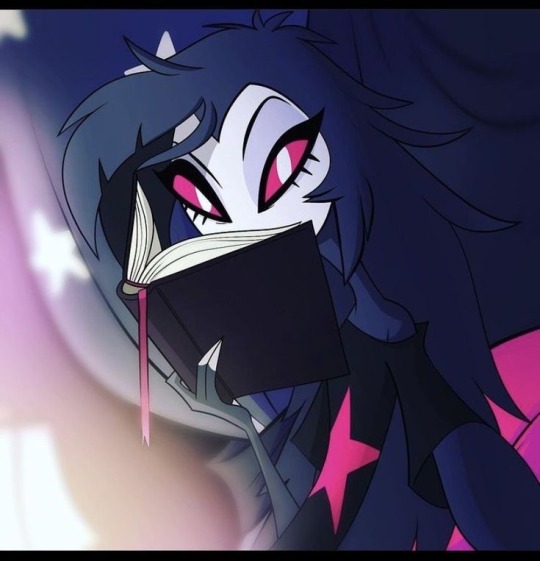
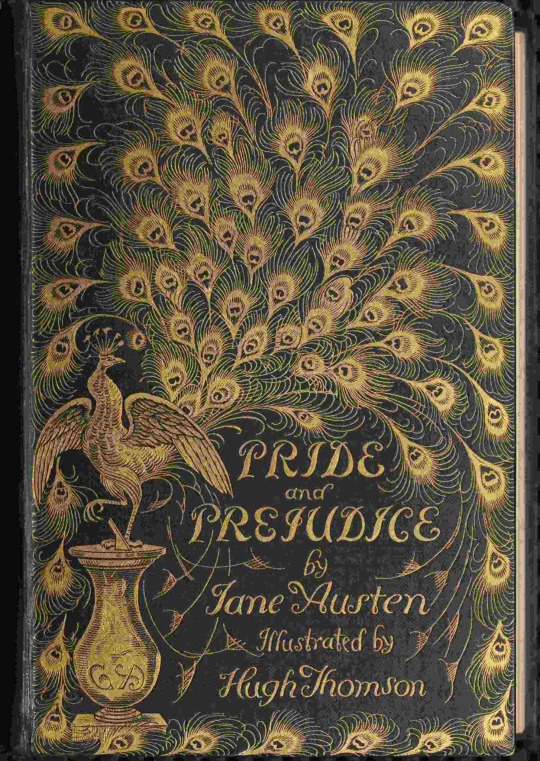

If I had to assign her an actual Goetia title, you know like exclusively her male family members all have (🙄 okay) it’d possibly be Andras as the most interesting choice, and given my headcanon that Andrealphus is possibly preying on and manipulating her, this new name is her way of reclaiming the name “Andy” and changing her surname to Octavia, discarding her patriarchal lineage. Since it’s pretty much guaranteed that Stolas is leaving his family to work with Blitzo his favourite clown, Octavias rank could fall from Princess to Marquise, as she will be governed by Andrealphus as a parental figure.
Or worse if he intends to marry her, a pretty good dark horror story though. (He of course is stopped and promptly killed and stuffed)


Octavia has traits of both owl and raven, and her being a dangerous trickster who sowes chaos and can kill masters is just a fascinating concept. Though I hope she’d spare the imp servants cause I want at least one royal to be kind to them. You think Andrealphus is a manipulator? You’ve seen nothing yet.
I just wanna see her F shit up, and who knows maybe Tex could become her guardian and magic familiar or something. It’s more close to a friendship than the servant type dynamic we see above. He gives her a piggy back ride so she can reach the books on the highest shelf and do some dusting.
I’m always down for connecting characters and making in depth demonology references. There’s endless potential there. Also. Lesbians with swords. Objectively cool. If she has any reference to Janis from Mean Girls (Her VA played Janis in one production) she is broody, weird and slightly off putting gothic and cynical yet funny, also is sapphic.
22 notes
·
View notes
Text
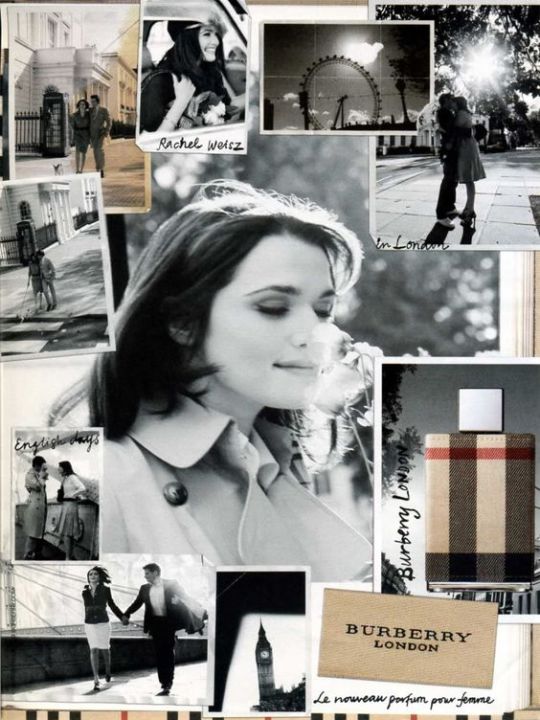





Continuing my journey through combining my two obsessions - perfume and The Libertines. In this edition, fragrances directly linked to the band in various ways.
London by Burberry - Notes of Honeysuckle, Jasmine, Musk and Sandalwood. Released in 2006. This is for lovers - of London. The imagery around this chic and clean little affair has always been a romantic postcard to the city that birthed it, and the iconic checked Burberry fabric wrapped around the bottle itself speaks to the rebirth of that heritage trend made edgy and new - most beautifully showcased in the infamous prison gates photos in 2003, where Peter and Carl each wore a matching Burberry trench and passed a Burberry scarf between them. Fake, probably, but that iconography was the absolute height of indie rock fashion.
Bluebell by Penhaligon's - Notes of Lily-of-the-Valley, Cyclamen, Cloves and Cinnamon. Released in 1978. Widely reported as a favourite perfume of Kate Moss during the time she and Peter were dating. I may not be much of a fan of hers, but who didn't want to know what Pete Doherty's girlfriend smelled like? Earthy, with its crushed flowers and herbs, a tad exclusive, with it's fancy lineage and posh price, but genuinely vintage - this was the exact sort of scent an indie girl in the 2000s picked if she wanted to stand out from the crowd.
Opium Pour Homme by Yves Saint Laurent - Notes of Black Currant, Star Anise, Bourbon Vanilla and Cedar. Released in 1995. Named by Peter as his favourite fragrance in the 2000s. I've never known if he was kidding, given the name - but this is a scent that absolutely suits him, and is my favourite for men of all time. Opening with bright, juicy berries, drying down into sweet vanilla and rich spice, it's an addictive potion that suits its moniker and defies the astringent, bathroom cleaner trend in men's fragrance with a high fashion dazzle that takes some courage to wear.
Bottega Veneta by Bottega Veneta - Notes of Bergamot, Jasmine, Leather and Patchouli. Released in 2011. This is a personal entry, as it's the one perfume that has gotten me a compliment from a Libertine. I am an aggressive over-sprayer, but only this one has elicited a comment, from Carl, after he embraced me following the Sharabang gig in 2018. "You smell amazing!" he said, to which I replied, "I think it's the leather", meaning the leather notes in the fragrance. "Leather?" he replied, completely confused. I didn't get a chance to elaborate, but this is indeed a leather bomb - loud like a brand new jacket, or better yet luxurious heels straight out of their box, with the crisp deliciousness of bergamot making it syrupy and lending a mouth-watering air. Tragically discontinued.
Comme des Garcons 2 Man by Comme des Garcons - Notes of Smoke, Betiver, Saffron, Leather and Incense. Released in 2004. One of the fragrances Carl mentioned wearing in the 2000s. A churchy, waxy, smoky scent that brings to mind a snuffed candle and is very evocative of the year it was released. Makes absolute sense that it's one he'd enjoy, leaning both into an esoteric side with it's midnight potions of nutmeg and mint, and a rock 'n' roll core with it's leather and incense - reminiscent of the intoxicating mix of sweat, tobacco and leather you'll find sticking to a musician fresh off a stage.
Ambre Sultan by Serge Lutens - Notes of Resin, Amber, Myrrh, Benzoin, Sandalwood, Vanilla and Myrtle. Released in 1993. Opulent, gothic and very warm, this unisex fragrance is another Carl listed as a favourite back in the day. If 2 Man is churchy, this one is culty. Again, it suits him - it's like festival hippy oil taken to it's most concentrated conclusion. I don't know if he still wears either of these - he smelled great in Melbourne in 2018, but when I asked what he had on, he joked, "Lynx Africa!" then denied he was wearing anything. Likewise, Peter arrived at the Hackney gig in 2019 smelling deliciously of something very like Tom Ford's Tobacco Vanille, but when I asked him what he had on, he just said, "I smell like a polecat".
34 notes
·
View notes
Text
What I read in 2023, pretty good going 👍 (apologies for long non sims post)
1. Middlemarch by George Eliot
2. Capitalism in the Twenty-First Century: Through the Prism of Value by Guglielmo Carchedi and Michael Roberts
3. The Temple House Vanishing by Rachel Donohue
4. The Book of Tokyo: A City in Short Fiction edited by Michael Emmerich, Jim Hinks & Masashi Matsuie
5. Clipped Coins, Abused Words, and Civil Government: John Locke's Philosophy of Money by George Caffentzis
6. Crashed: How a Decade of Financial Crises Changed the World by Adam Tooze
7. Mexican Gothic by Silvia Moreno-Garcia
8. Civilizing Money: Hume, his Monetary Project and the Scottish Enlightenment by George Caffentzis
9. An Untouched House by Willem Frederik Hermans
10. Life Ceremony by Sayaka Murata
11. Act of Oblivion by Robert Harris
12. Fireheart Tiger by Aliette de Bodard
13. Exiles from European Revolutions: Refugees in Mid-Victorian England edited by Sabina Freitag
14. The Apprenticeship of Big Toe P by Rieko Matsuura
15. A Civil War: A History of the Italian Resistance by Claudio Pavone
16. Mrs Caliban by Rachel Ingalls
17. Dracula by Bram Stoker
18. The Silent Dead by Tetsuya Honda
19. Lady Susan by Jane Austen
20. Adam Smith in Beijing: Lineages of the Twenty-First Century by Giovanni Arrighi
21. This Should be Written in the Present Tense by Helle Helle
22. The Citadel of Weeping Pearls by Aliette de Bodard
23. The Invention of Art: A Cultural History by Larry Shiner
24. Sister, Maiden, Monster by Lucy A. Snyder
25. The Mismeasure of Man by Stephen Jay Gould
26. Ninety-Three by Victor Hugo
27. Carol by Patricia Highsmith
28. Victorian Women Writers and the Woman Question edited by Nicola Diane Thompson
29. Some Recent Attacks: Essays Cultural & Political by James Kelman
30. Mem by Bethany C. Morrow
31. Russia Under Yeltsin and Putin by Boris Kagarlitsky
32. Station Eleven by Emily St. John Mandel
33. The History of the British Film 1918-1929 by Rachael Low
34. The Law of Accumulation and Breakdown of the Capitalist System by Henryk Grossman
35. Mayhem & Death by Helen McClory
36. White by Marie Darrieussecq
37. Dream Houses by Genevieve Valentine
38. The Vanishers' Palace by Aliette de Bodard
39. Maigret Takes a Room by Georges Simenon
40. The Lodger, That Summer by Levi Huxton
41. Mistakes Were Made by Meryl Wilsner
42. Grundrisse by Karl Marx
43. A Marvellous Light by Freya Marske
44. Our Wives Under the Sea by Julia Armfield
31 notes
·
View notes